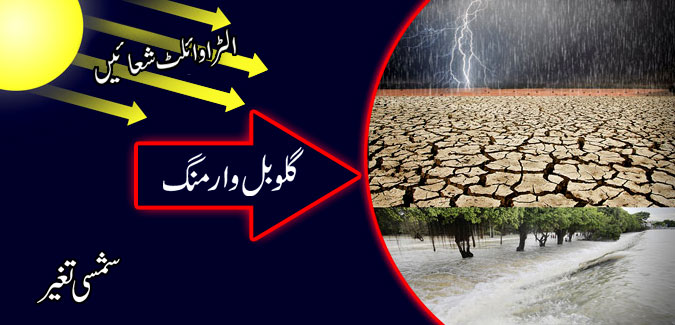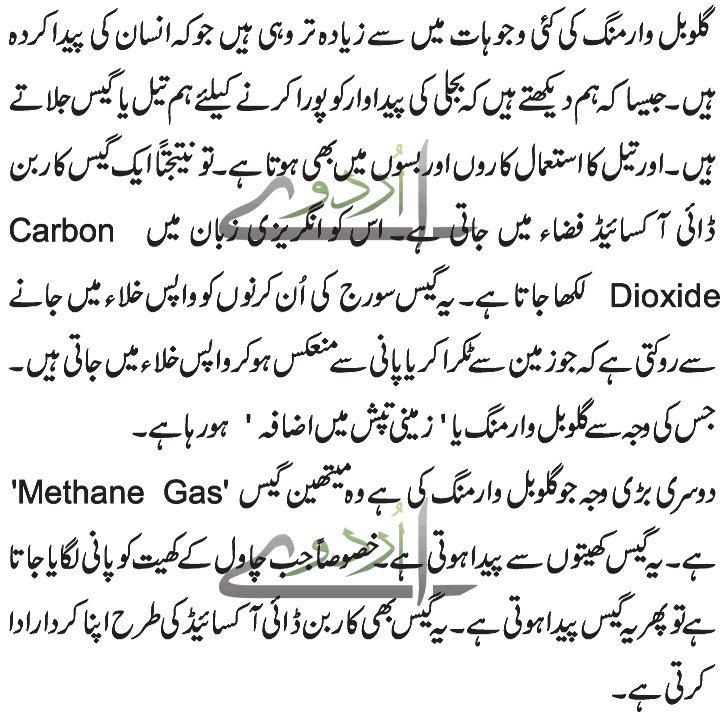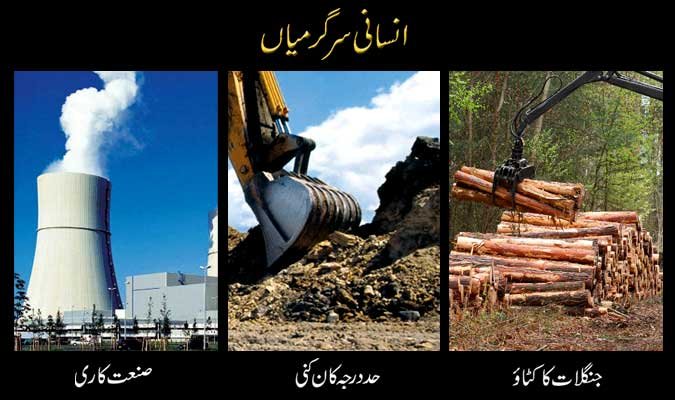Causes Of Global Warming Detail In Urdu








Before learning about the causes of global warming in Urdu and English, you need to know the ground realities about the earth’s climate system that makes life thrive on this beautiful but fragile planet.
Do you know the earth is wrapped in a thick layer of greenhouse gases which acts as a thermal blanket for the earth? This layer consists primarily of water, carbon dioxide, nitrous oxide and methane. The solar radiation, which serves as a source of energy for all life on planet, passes through this blanket to reach the earth’s surface.
After passing through the atmosphere, the sunlight warms the earth’s surface and the remainder of the solar radiation is bounced back into the space.
But the blanket of greenhouse gases traps and absorbs most of the outgoing heat which is re-emitted in all the directions. As a result, the surface of the earth and lower atmosphere get warmer.
The Cause of Global Warming:
The factors responsible for global warming can be grouped in two categories, i.e. natural causes and human influence. Let’s discuss and evaluate their effects one by one. If you like, you can also read the causes of global warming in Urdu.
Natural Causes of Climate Change:
The natural phenomenon responsible for global warming include the orbital changes, volcanic eruptions, variation in solar radiation and movement of crustal plates.
- Orbital Changes:
According to Milankovitch theory, the earth’s orbit and tilt experience three cyclical changes which cause fluctuations in the climate system. Theses cyclic changes involve change in the shape or eccentricity of the orbit, tilt or obliquity of axis and the wobbling or precession of axis. However, these climate fluctuations occur over the period of tens of thousands of years to hundreds of thousands of years.
Owing to the interplay of the 3 orbital cycles, different amount of solar radiation is received at different altitudes over the course of the year.
- Volcanic Eruptions: Volcanic eruption is another natural phenomenon responsible for climate change. But, quite interestingly, these eruptions cause global cooling instead of warming the climate. No doubt, they discharge carbon dioxide into the atmosphere, but its effects are countered by the emission of aerosols. The volcanic aerosols, which include solid and liquid particles, salt, dust, soot, crystals, viruses and bacteria, float around in the air and scatter the incoming solar radiation to cause a cooling effect.
- Sunspots: The development of darker areas or sunspots, on the surface of the sun, causes variation in solar radiation. During the active periods of sunspots, the sun emits slightly more radiation. As the sunspots suppress heat, the heat flows to the surrounding areas which become brighter than normal and radiate more heat. So, an increase in sunspots poses the risk of global warming, and vice versa.
- Plate Tectonics: The movement of tectonic plates over the geological timescales carries along the landmasses to different positions and latitudes. Such changes in the position and latitude of landmasses lead to changes in the circulation of air and ocean water at the global level. So, the climate of the continents changes.
Human Influence on Climate System:
The Synthetic Report (SYR) issued by the Intergovernmental Panel on Climate Change (IPCC), published in 2015, confirms the clear and growing influence of human activities on the climate change. The report observes such influence across all the continents and oceans of the world.
The IPCC (scientific and intergovernmental body) is 95% sure that human activities are the major cause of the current levels of global warming. The report also finds that the more the human influence disturbs the climate system, the greater the risks of severe and irreversible impacts for people and the ecosystems.
Various economic and other human activities cause the accumulation of air pollutants and greenhouse gases in the atmosphere, like carbon dioxide, chlorofluorocarbons, methane, nitrous oxide and water vapors. Such elements trap the radiation that has bounced off the earth’s surface and radiate it back to the surface.
Effects of Global Warming:
The researchers have developed a close relationship between global warming and harsh weather. The rising temperature causes hotter and longer heat waves and droughts, stronger hurricanes and heavier downpour.
The tropical storms pick up more energy and become more powerful and devastating.
Meanwhile, early snowmelt, unprecedented water shortages, heavier flooding, spread of infectious diseases and extinction of many animal and plant species are some of the other causes of global warming.
Alarming and Interesting Facts on Causes of Global Warming:
- Did you know 90% of the infrared heat bouncing back from the earth’s surface is absorbed by greenhouse gases and radiated back towards the surface?
- The heat trapped by greenhouse gas molecules warms the surface of the earth to the life-supporting average of 15 degrees Celsius.
- The discharge of carbon dioxide by a volcano is countered by the emission of aerosols.
- Did you know aerosols emitted by the volcanoes cause a slight cooling effect in the atmosphere?
- The cooling effect caused by the volcanic aerosols may last for 1 to 2 years.
- The “Year Without Summer” is the name given to the year 1816 which occurred after the violent eruption of the Mount Tambora in Indonesia. It is also considered as the largest known volcanic eruption in the history of human civilization!
- Over the past 50 years, the average global temperature has been rising at the fastest rate!
- Did you know 17 of the 18 warmest years on record have occurred since 2001 (i.e. in the first 17 years of 21st century)!
- The average temperature of the earth’s climate system has risen by 1.8 0F since the year 1880.
- The amount of carbon dioxide in the atmospheric air is at the highest level in 650,000 years!
- The year 2012 witnessed the shrinking of the summer sea ice of the Arctic to the lowest degree in history.
- The climate change is causing an increase of 3.2 millimeters in the sea level per year.
- Did you know the June 2018 was the third warmest June in the past 138 years?
- The burning of fossil fuels in the US produces around 2 billion tons of carbon dioxide every year!
- In the recent years, tens of thousands of people have died due to extreme heat waves, resulting from climate change.
- Antarctica has been losing about 134 billion metric tons of ice every year since the year 2002.
- In the past 100 years, the sea levels have increased by 7 inches.











